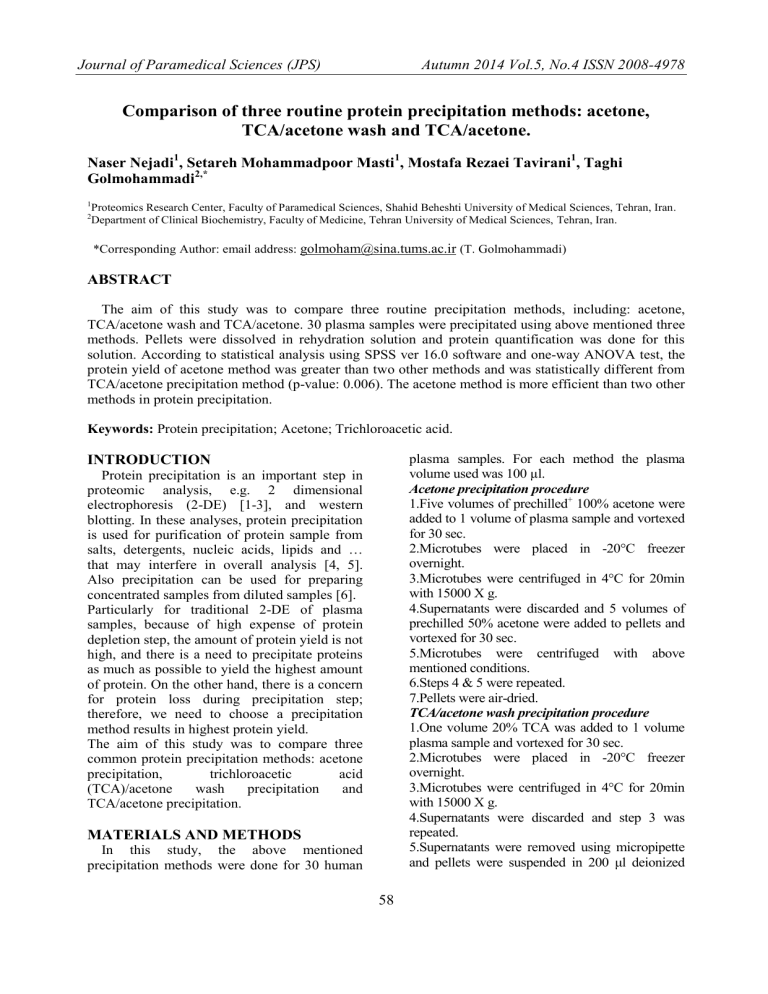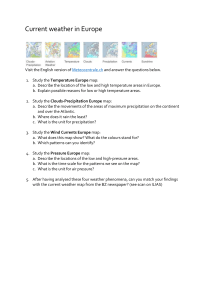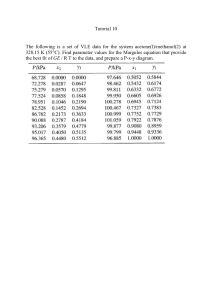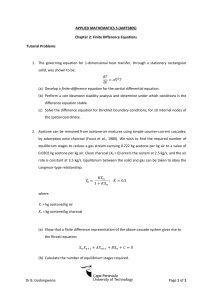
Journal of Paramedical Sciences (JPS) Autumn 2014 Vol.5, No.4 ISSN 2008-4978 Comparison of three routine protein precipitation methods: acetone, TCA/acetone wash and TCA/acetone. Naser Nejadi1, Setareh Mohammadpoor Masti1, Mostafa Rezaei Tavirani1, Taghi Golmohammadi2,* 1 Proteomics Research Center, Faculty of Paramedical Sciences, Shahid Beheshti University of Medical Sciences, Tehran, Iran. Department of Clinical Biochemistry, Faculty of Medicine, Tehran University of Medical Sciences, Tehran, Iran. 2 *Corresponding Author: email address: golmoham@sina.tums.ac.ir (T. Golmohammadi) ABSTRACT The aim of this study was to compare three routine precipitation methods, including: acetone, TCA/acetone wash and TCA/acetone. 30 plasma samples were precipitated using above mentioned three methods. Pellets were dissolved in rehydration solution and protein quantification was done for this solution. According to statistical analysis using SPSS ver 16.0 software and one-way ANOVA test, the protein yield of acetone method was greater than two other methods and was statistically different from TCA/acetone precipitation method (p-value: 0.006). The acetone method is more efficient than two other methods in protein precipitation. Keywords: Protein precipitation; Acetone; Trichloroacetic acid. plasma samples. For each method the plasma volume used was 100 µl. Acetone precipitation procedure 1.Five volumes of prechilled+ 100% acetone were added to 1 volume of plasma sample and vortexed for 30 sec. 2.Microtubes were placed in -20°C freezer overnight. 3.Microtubes were centrifuged in 4°C for 20min with 15000 X g. 4.Supernatants were discarded and 5 volumes of prechilled 50% acetone were added to pellets and vortexed for 30 sec. 5.Microtubes were centrifuged with above mentioned conditions. 6.Steps 4 & 5 were repeated. 7.Pellets were air-dried. TCA/acetone wash precipitation procedure 1.One volume 20% TCA was added to 1 volume plasma sample and vortexed for 30 sec. 2.Microtubes were placed in -20°C freezer overnight. 3.Microtubes were centrifuged in 4°C for 20min with 15000 X g. 4.Supernatants were discarded and step 3 was repeated. 5.Supernatants were removed using micropipette and pellets were suspended in 200 μl deionized INTRODUCTION Protein precipitation is an important step in proteomic analysis, e.g. 2 dimensional electrophoresis (2-DE) [1-3], and western blotting. In these analyses, protein precipitation is used for purification of protein sample from salts, detergents, nucleic acids, lipids and … that may interfere in overall analysis [4, 5]. Also precipitation can be used for preparing concentrated samples from diluted samples [6]. Particularly for traditional 2-DE of plasma samples, because of high expense of protein depletion step, the amount of protein yield is not high, and there is a need to precipitate proteins as much as possible to yield the highest amount of protein. On the other hand, there is a concern for protein loss during precipitation step; therefore, we need to choose a precipitation method results in highest protein yield. The aim of this study was to compare three common protein precipitation methods: acetone precipitation, trichloroacetic acid (TCA)/acetone wash precipitation and TCA/acetone precipitation. MATERIALS AND METHODS In this study, the above mentioned precipitation methods were done for 30 human 58 Journal of Paramedical Sciences (JPS) Autumn 2014 Vol.5, No.4 ISSN 2008-4978 water. Pellets should were dispersed, but were not dissolved by the water. 6.Two ml prechilled 100% acetone was added to microtubes. 7.Microtubes were placed in -20°C freezer and vortexed 30 sec every 15 min. 8.Microtubes were centrifuged with above mentioned conditions. 9.Supernatants were discarded and pellets were air-dried. TCA/acetone precipitation procedue 1.Three volumes of 13.3% w/v TCA in acetone were added to 1 volume plasma sample and vortexed for 30 sec. 2.Microtubes were placed in -20°C freezer overnight. 3.Microtubes were centrifuged in 4°C for 20min with 15000 X g. 4.Supernatants were discarded and step 3 was repeated. 5.Supernatants were removed using micropipette and pellets were suspend in 200 μl deionized water. Pellets should were dispersed, but were not dissolved by the water. 6.2 ml prechilled 100% acetone containing 20 mM DTT was added to microtubes. 7.Microtubes were placed in -20°C freezer and vortexed 30 sec every 15 min. 8.Microtubes were centrifuged with above mentioned conditions. 9.Supernatants were discarded and pellets were air-dried. Pellets were dissolved in 2.5ml rehydration solution containing 7M urea, 2M thiourea, 2% w/v chaps and 40mM DTT. Then protein quantification was done in triplicate using 2D Quant Kit (GE Healthcare). 10µl of rehydration solution containing protein was used for this purpose and results were expressed in µg/10µl of this solution. Figure 1. Comparison of protein yield in three precipitation methods. It is also noteworthy that the efficiency of acetone precipitation is 19.72% higher than TCA/acetone wash precipitation method (figure 1). DISCUSSION Protein precipitation is of great importance in proteomic analysis and the most efficient and easier method should be used for proteomic analysis. Among the methods compared, acetone precipitation was the most efficient. This finding is consistent with Fic et al. findings. In their study, they compared precipitation methods for rat brain, and the efficiency of acetone precipitation method was near 2fold greater than TCA precipitation method. It was noted that solubilisation of TCA precipitation method pellets was weak compared with acetone precipitation [7]. May be the complexity of the method is involved in its efficiency, the more complexity results in the less efficiency. On the other hand, the volume of acetone used in initial step of acetone precipitation method is greater than the volume of TCA and TCA/acetone solution used RESULTS Statistic analysis was done using one-way ANOVA test with SPSS software ver.16. The calculated mean for three methods for 10µl of solution were 12.2187 µg for acetone precipitation, 9.8086 µg for TCA/acetone wash precipitation and 6.61909 µg for TCA/acetone precipitation. Among these methods, there was only a statistically significant difference between acetone precipitation and TCA/acetone precipitation methods (p-value: 0.006). 59 Journal of Paramedical Sciences (JPS) Autumn 2014 Vol.5, No.4 ISSN 2008-4978 in initial step of 2 other methods and may be involved in efficiency of this method. Also in this study, it was noted that the stability of the pellets of acetone precipitation method was more than 2 other methods and performing TCA/acetone wash and TCA/acetone precipitation methods needed more care than acetone precipitation method. CONCLUSION REFERENCES samples prior to two-dimensional polyacrylamide gel electrophoresis. Biotechnol. Lett. 2003;25, 1899–1903. 5.Antonioli P, Bachi A, Fasoli E, et al. Efficient removal of DNA from proteomic samples prior to two-dimensional map analysis. J. Chromatogr.2009; A 216, 3606–3612. 6.Zellner M, Winkler W, Hayden H, et al. Quantitative validation of different protein precipitation methods in proteome analysis of blood platelets. Electrophoresis 2005;26, 2481– 2489. 7. Fic E, Kedracka-Krok S, Jankowska U, et al. Comparison of protein precipitation methods for various rat brain structures prior to proteomic analysis. Electrophoresis, 2010;31, 3573-3579. Among routine precipitation methods, acetone method is more efficient because of its easier performance, pellet stability and pellet solubility. For precipitation the method of choice should be easier as possible. This will result in more protein yield and presumably more spots in 2-DE analysis. 1.Lilley KS, Razzaq A, Dupree P. Twodimensional gel electrophoresis: recent advances in sample preparation, detection and quantitation. Curr. Opin. Chem. Biol. 2002;6, 46–50. 2.Shaw MM, Riederer BM. Sample preparation for two-dimensional gel electrophoresis. Proteomics. 2003;3, 1408–1417. 3.Hirano M, Rakwal R, Shibato J, et al. New protein extraction/solubilization protocol for gel-based proteomics of rat (female) whole brain and brain regions. Mol. Cells. 2006;22, 119–125. 4.Garcia-Rodriguez S, Castilla SA, Machado A, et al. Comparison of methods for sample preparation of individual rat cerebrospinal fluid 60



